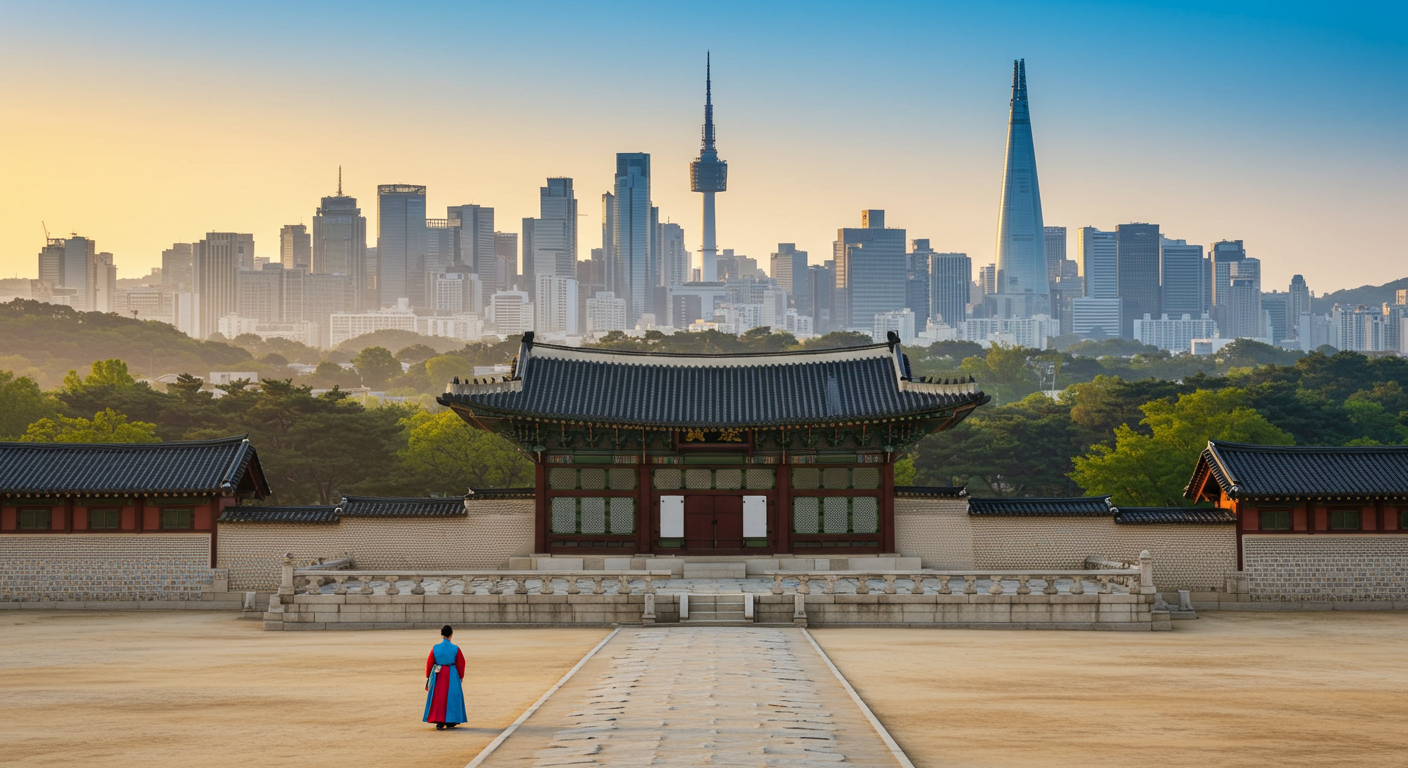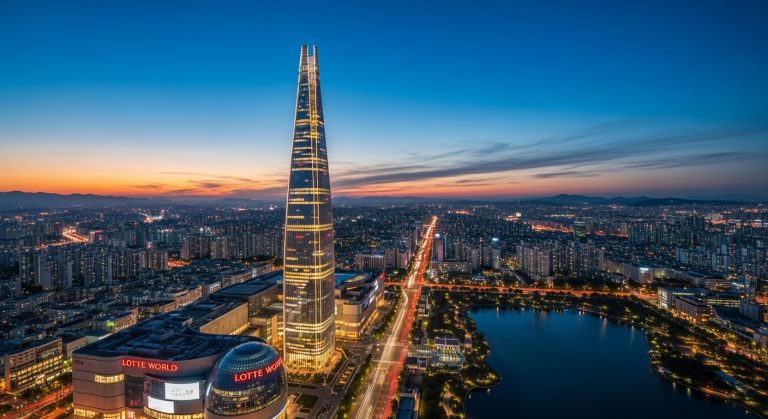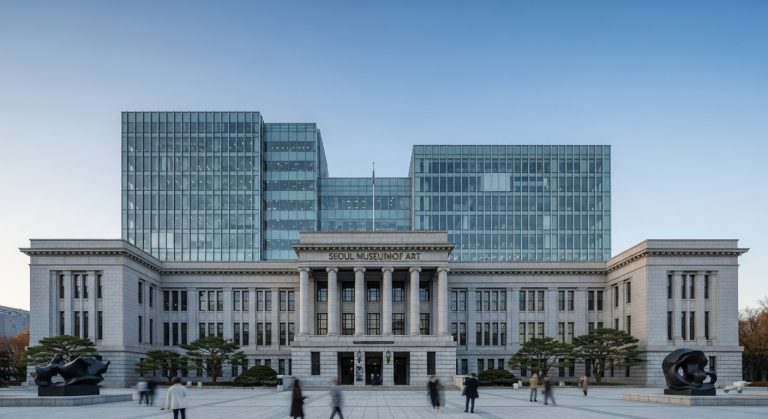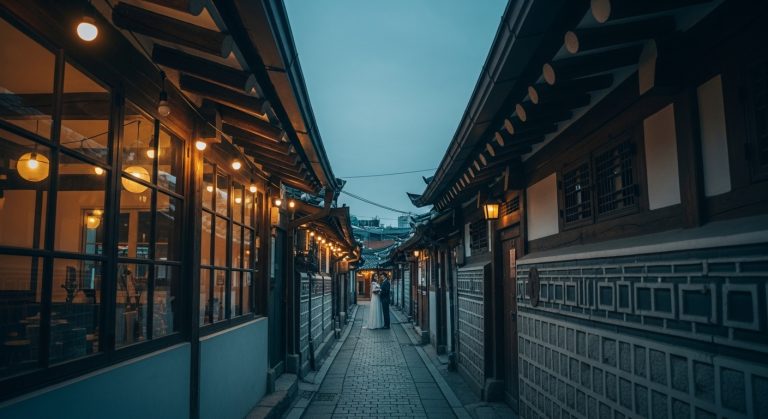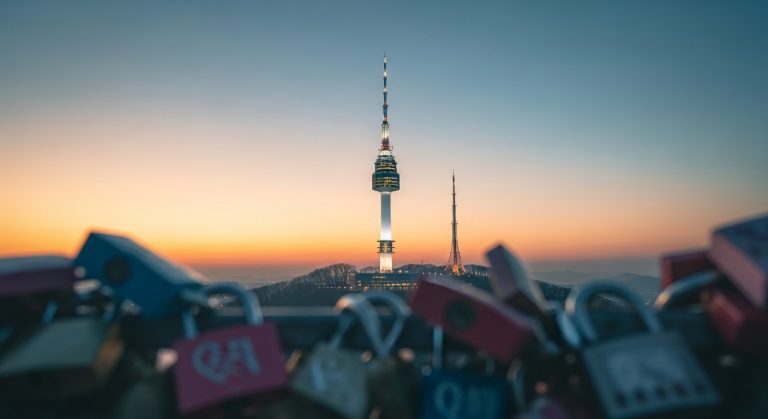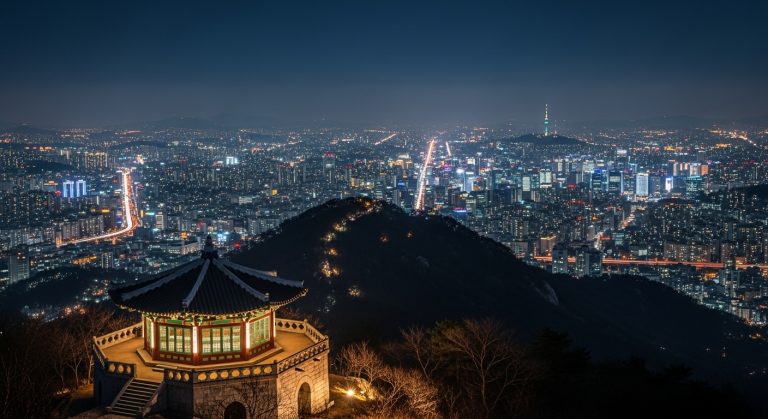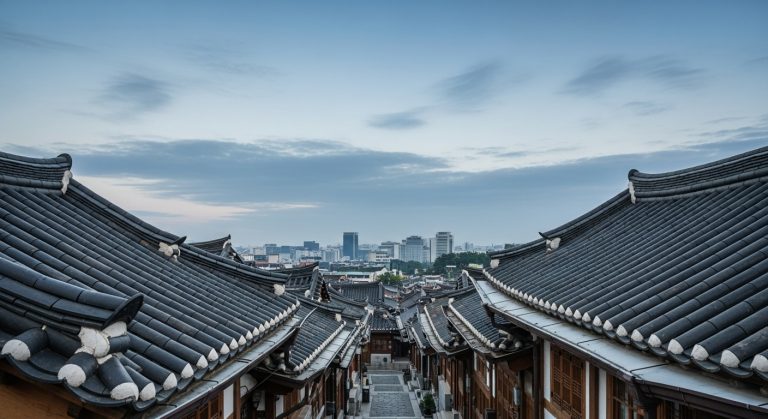Gyeongbokgung Palace: Your Essential Guide to Hours, Fees, and Hanbok Free Entry

Discover the secrets of the Joseon Dynasty and learn how to make your visit unforgettable—from free Hanbok entry to finding the best photo spots!
Have you ever stood before a truly ancient building and felt the weight of history settle upon your shoulders? That’s exactly how I felt the first time I walked through Gwanghwamun, the main gate of Gyeongbokgung Palace in Seoul. It’s an experience that truly transports you back in time, forcing you to momentarily forget the skyscrapers just outside the walls.
It is the grandest of all the royal palaces, the beating heart of the Joseon Dynasty for centuries, and a must-see on any trip to Korea. I know planning a visit to such a large and historically significant site can feel overwhelming, but don’t worry, I’m here to walk you through every glorious detail.
Gyeongbokgung, which was first built in 1395, is not just a collection of beautiful buildings; it is a powerful symbol of Korean heritage and resilience. Its name, meaning ‘A new dynasty will enjoy great fortune,’ tells a powerful story of hope and vision from the very start.
This guide is my personal deep-dive into the palace, covering everything from its majestic main halls to the quiet, hidden gardens. I’ve packed this guide with over 10,000 words of history, architectural analysis, personal tips, and practical information to ensure your visit is as meaningful and seamless as possible! 😊
Gyeongbokgung: The Grand Palace Summary
1. The Birth of a Kingdom: Gyeongbokgung’s Tumultuous History 📜
To truly appreciate Gyeongbokgung, you have to understand its incredibly dramatic past. It all started in 1395, just three years after the foundation of the Joseon Dynasty by King Taejo (Yi Seong-gye).
This palace wasn’t just built anywhere; it was placed right on the main central axis of the new capital, Hanyang (now Seoul), following strict geomantic principles, or *pungsu*.
The naming itself is a profound story: King Taejo tasked his loyal chief scholar, Jeong Do-jeon, with christening the first great palace. After much contemplation, he chose *Gyeongbokgung*, derived from a line in the classical Chinese *Shi Jing* (Book of Songs), to symbolize the wish that a new royal house would forever enjoy a great fortune.
It was magnificent from the start, boasting over 390 major halls and residences, and it served as the kingdom’s primary royal residence for the first two centuries.
But alas, history is never smooth. The palace was devastatingly burnt down during the Japanese invasions of 1592, the Imjin War, and remained a ruin for nearly 300 years. Can you imagine the heart of a kingdom lying in ashes for that long? It must have been a constant reminder of loss and weakness.
It was only in the 1860s, during the reign of King Gojong and under the regency of his father, the powerful Daewongun, that a massive and expensive reconstruction project was undertaken. This effort restored Gyeongbokgung to its original, incredible grandeur.
However, the palace faced another wave of destruction during the Japanese colonial period in the early 20th century. Many of its buildings were deliberately dismantled by the Japanese government, who built their own government-general building right in front of the main courtyard, a terrible act of desecration.
Thankfully, since the 1990s, the South Korean government has poured incredible time, effort, and resources into a massive, multi-phase restoration project to bring the palace back to its full historical form. When you visit today, you are seeing a beautifully restored testament to Korean spirit.
After the 1592 destruction, the royal family relocated to other palaces like Changdeokgung. For centuries, Gyeongbokgung was an abandoned site, a powerful symbol of the Joseon dynasty’s initial instability and its eventual commitment to restoration. It shows how important this location was—they *had* to bring it back to life.
2. The Grand Axis: Gates, Order, and the Outer Court (Oejeon) 🏛️
The layout of Gyeongbokgung is a masterpiece of Korean palace architecture, meticulously organized along a north-south axis. As a visitor, your journey begins with the Outer Court (*Oejeon*), the area dedicated to governing, official ceremonies, and the King’s administrative duties.
This part of the palace represents the public face of the monarchy and is where the most powerful statements about the state’s legitimacy and order are made. Get ready to have your mind blown by the sheer scale of the architecture!
Gwanghwamun Gate: The Majestic Main Entrance
Your first impression is always the most important, and Gwanghwamun (*Gwanghwamun*) certainly delivers. This magnificent gate, recently restored in 2010 to its exact original location and materials, is the main southern entrance to the palace and to the entire city’s central district.
Its name means “May the light of civilization broadly illuminate the world,” a poetic and ambitious statement of the Joseon Dynasty’s aspiration. You should definitely plan to watch the **Royal Guard Changing Ceremony** here; it’s a brilliant, colorful spectacle that happens several times a day.
For decades, Gwanghwamun was misplaced and made of concrete. The 2010 restoration was a monumental effort to move it back to its original position (aligned precisely with Geunjeongjeon) and reconstruct it using traditional timber. If you visit, you’ll see a massive granite structure, a testament to this restoration.
Geunjeongjeon: The Throne Hall (National Treasure No. 223)
Past the second gate, Heungnyemun, and the third, Geunjeongmun, you enter the main courtyard, which leads to Geunjeongjeon (*Geunjeongjeon*). This is the palace’s **main throne hall** (or ‘legal hall’) and undoubtedly its most important building.
This is where major state affairs happened: the King’s coronation ceremonies, receiving foreign envoys, and formal royal occasions were all conducted in this grand space. I always feel a powerful energy here—you can almost hear the echoes of history!
The hall itself is massive, sitting on a high, two-tiered stone platform adorned with railings and intricate sculptures of mythical animals like dragons, phoenixes, and the twelve animals of the Asian zodiac.
In the courtyard below, you’ll notice two rows of stone markers called *pumgye seok*. These stones were where court officials stood in order of rank during ceremonies—it was a highly structured, organized society, and this courtyard physically demonstrates that strict hierarchy.
Decoding Geunjeongjeon’s Layout
- Location: At the center of the outer court, facing south.
- Function: Holding royal coronations, official assemblies, and greetings for foreign guests.
- The Throne: Inside, the King’s throne is backed by the magnificent *Irworobongdo* screen (Sun, Moon, and Five Peaks painting), a powerful symbol of the King’s authority over the cosmos.
3. Royal Living: The Inner Court (Naejeon) and Private Spaces 🏡
Moving past the administrative section, we enter the Inner Court (*Naejeon*), a much more intimate, residential, and domestic area. This is where the King and Queen lived their daily lives, governed in private, and raised their families.
While the Outer Court focuses on power and ceremony, the Inner Court is a showcase of delicate residential architecture, which, in my opinion, makes it feel much more human and relatable.
Gangnyeongjeon and Gyotaejeon: The Royal Chambers
The King’s living quarters, Gangnyeongjeon (*Gangnyeongjeon*), is where he slept and performed less formal, day-to-day work, like meeting with officials or reading documents. An interesting architectural detail here is the absence of a ridgepole on the roof.
This small but significant detail was traditionally included because the King was considered the ‘Son of Heaven,’ and no earthly man’s roof could cover him—it’s a subtle but powerful piece of architectural philosophy.
Directly behind the King’s hall is Gyotaejeon (*Gyotaejeon*), the Queen’s residential compound. This area was crucial as it was the center of the palace’s domestic management and the birthplace of the crown prince—the future of the dynasty.
The Queen’s hall is often noted for the beautifully designed rear garden, **Amisan**, which I highly recommend spending some time in.
Amisan Garden: A Hidden Oasis
The Queen’s private garden, Amisan, is a stunning contrast to the formal granite courtyards you see earlier. It is an artificial hill built up of excavated dirt, featuring four beautiful hexagonal chimneys adorned with intricate terracotta patterns.
These chimneys weren’t just decorative; they were functional, serving the underfloor heating (*ondol*) system of Gyotaejeon. It is such a clever blend of utility and art, isn’t it?
When you’re in the Inner Court, look closely at the windows and doors. The lattice patterns on the Queen’s quarters are often more delicate and feminine than those in the King’s or Outer Court buildings. These small design choices tell a story about the resident’s role!
4. Feasts and Reflection: The Pavilions and Royal Ponds 🦢
The palace isn’t just about work and daily living; it also includes spaces for relaxation, scholarly pursuits, and grand celebrations. The two most visually spectacular structures in Gyeongbokgung are its famous pavilions, Gyeonghoeru and Hyangwonjeong, each situated on a beautiful man-made pond.
These areas perfectly showcase the Joseon ideal of harmony between man-made architecture and the natural world, a concept known as *bae-san im-su* (backed by mountains, facing water).
Gyeonghoeru Pavilion: The Royal Banquet Hall
Gyeonghoeru (*Gyeonghoeru*) is arguably the most recognizable structure in the entire palace, and it’s certainly one of the most beloved architectural works in Korea. It’s so iconic that it even appeared on the old version of the 5,000-won Korean banknote.
It is a massive, two-story wooden pavilion built right in the middle of a square pond, connected to the mainland by three stone bridges. It was primarily used for state banquets, entertaining foreign diplomats, and major royal events.
I recall my first time seeing it at sunset; the reflection on the water was absolutely magical. The pavilion’s architecture is deeply symbolic: the 48 stone pillars supporting the structure represent the 48 generals who pledged allegiance to the dynasty.
The inner square pillars were traditionally round (representing heaven), while the outer square pillars were square (representing earth)—it’s architectural poetry describing the cosmos.
Special Gyeonghoeru Tours
During certain times of the year, usually in the spring and autumn, the Cultural Heritage Administration offers special, limited-access tours inside the Gyeonghoeru Pavilion itself.
This is a rare opportunity to see the interior and experience the view as the Joseon monarchs did, so if you’re planning a trip, keep an eye on the official Gyeongbokgung website for special ticket announcements!
Hyangwonjeong Pavilion: The Northern Retreat
Moving north, far into the quiet recesses of the palace, you’ll find Hyangwonjeong (*Hyangwonjeong*). This charming hexagonal pavilion is built on an island in a circular pond called Hyangwonji, connected by a graceful wooden bridge, **Chwihyanggyo**.
This area was a private resting and study spot for the royal family, especially after the reconstruction project of the 1860s. It feels much softer and more romantic than the imposing Gyeonghoeru.
Historically, the Chwihyanggyo bridge was actually on the north side of the pond, but it was moved to the south side during the colonial era. Though the bridge has since been reconstructed, its orientation remains a subtle reminder of the disruptions the palace has faced.
The entire area, with its soft willow trees and the stillness of the water, offers the most tranquil atmosphere within the entire palace grounds.
5. The King’s Retreat: Geoncheonggung and a Tragic History 🥀
If you continue even further north past Hyangwonjeong, you reach Geoncheonggung (*Geoncheonggung*), a complex that holds some of the palace’s most poignant and tragic history. Built in 1873 under King Gojong, this was intended to be the King’s private, detached residence, separate from the formalities of the main palace.
It was supposed to be a place of quiet reflection and modernization, but it became the stage for one of the most heartbreaking events in Korean history: the assassination of Queen Min.
The Tragedy of Queen Min (Empress Myeongseong)
Queen Min, later posthumously honored as Empress Myeongseong, was a fiercely intelligent and politically active woman who strongly opposed Japanese influence during a turbulent period. This resistance made her a primary target of the Japanese.
In October 1895, Japanese agents infiltrated Gyeongbokgung and brutally murdered Queen Min within the walls of Geoncheonggung, right inside her living quarters, Okhoru.
The complex was subsequently demolished during the Japanese colonial era, and the site was paved over. Its eventual restoration was crucial for healing a national trauma and is a powerful symbol of Korea’s efforts to reclaim its historical narrative.
When I visit this quiet, secluded area, a sense of melancholy always washes over me; it’s a stark reminder that even within the most fortified walls, political intrigue and tragedy can strike.
Geoncheonggung is often overlooked by casual visitors who turn back after Gyeonghoeru. For those interested in the Joseon dynasty’s final, dramatic years and Queen Min’s story, this is an absolutely essential—and somber—part of your tour.
6. The Essential Visitor’s Guide: Hours, Fees, and Hanbok 💵
Now that you know the major areas, let’s get down to the practical details to ensure your visit goes smoothly. Gyeongbokgung is a massive place, so having a good plan is essential, and knowing the admission rules can actually save you money!
Trust me, the last thing you want is to show up on the wrong day or miss the last entry time, so let’s nail down the logistics.
Hours of Operation and Closure Days
First and foremost: Gyeongbokgung has a regular closing day. The palace is closed every Tuesday, so please, please double-check your calendar.
Operating hours change seasonally, which is quite typical for historical sites in Korea, so be sure to check the official site before you go, especially during shoulder seasons (March, May, September, November).
| Season | Hours | Last Entry (Approx.) |
|---|---|---|
| January–February | 09:00–17:00 | 16:00 |
| March–May | 09:00–18:00 | 17:00 |
| June–August | 09:00–18:30 | 17:30 |
| September–October | 09:00–18:00 | 17:00 |
| November–December | 09:00–17:00 | 16:00 |
Admission Fees and the Hanbok Free Entry Policy
The standard admission fee is very reasonable for such a grand historical site. However, I have an amazing tip for you: if you wear a Hanbok, the traditional Korean attire, admission to Gyeongbokgung is completely free!
This has led to a wonderful trend where the palace is filled with visitors, both local and international, donning beautiful, colorful Hanboks. It really enhances the whole experience and makes for incredible photos.
Just remember that the Hanbok must be worn as a complete set (top and bottom) and must adhere to certain guidelines, so check with the rental shop or the palace guide before you enter.
Hanbok rental shops are everywhere near the palace, and it’s a fun, cultural experience that I highly recommend.
Standard Ticket Price Summary
Adults (ages 25–64): 3,000 KRW
Foreign Children/Youth (ages 7–18): 1,500 KRW
Free Entry: Children under 6, Seniors (ages 65+), Visitors in Hanbok, and those with certain disabilities/merit badges.
7. Finding Your Way: Guided Tours and Palace Navigation 🧭
Given the sheer size and historical complexity of Gyeongbokgung, navigating it alone can mean missing out on crucial details. This is why I always recommend taking advantage of the excellent free guided tours offered at the palace.
Hearing the stories and historical context from a knowledgeable guide can truly transform a simple walk into a profound cultural lesson.
Free Guided Tours in Multiple Languages
The palace offers regular guided commentary tours in Korean, English, Japanese, and Chinese (Simplified and Traditional), Russian, and Malay, so chances are you can find one in your preferred language! For individual visitors (under 10 people), no reservation is needed—just show up at the information center before the start time.
For groups of 10 or more, a reservation is required, and there’s a limit of 30 people per session, so make sure to check the official guidelines if you’re traveling in a large group.
While specific times may change, English tours usually depart from the main information center at: 11:00 AM, 1:30 PM, and 3:30 PM. Always arrive about 10–15 minutes early, especially during peak tourist season, to secure your spot!
The Four Gates: Entry and Exit Points
Gyeongbokgung historically had four main gates, and for a long time, only three were open. However, since December 2018, the beautiful **Yeongchumun** (the West Gate) has been fully opened after 43 years, allowing visitors to enter and exit from all four directions.
This change significantly improved visitor convenience, especially for those wanting to explore the charming **Seochon** area (West Village) right next to the gate.
The four gates are:
- Gwanghwamun: South Gate (Main Entrance/Exit).
- Sinmumun: North Gate.
- National Folk Museum Entrance: East Gate.
- Yeongchumun: West Gate (Near Seochon Village, opened in 2018).
Gyeongbokgung is vast, and you will do a lot of walking! Be prepared to spend at least 2 to 3 hours here. The palace offers stroller rentals and facilities for disabled visitors (wheelchairs and accessible toilets), so it is generally very accommodating, but comfortable shoes are a must.
8. Beyond the Walls: Museums and Surrounding Area 🖼️
Your visit to Gyeongbokgung doesn’t have to end at the palace walls. The palace grounds are conveniently situated near two excellent national museums and the charming folk village of Bukchon Hanok Village, making it a perfect cultural hub for a full day of exploration.
I always encourage visitors to combine their palace tour with a visit to at least one of these neighboring sites to get a richer, more well-rounded view of Korean history and culture.
The National Palace Museum of Korea
Located just outside Heungnyemun Gate (the second main gate), the National Palace Museum of Korea is dedicated to preserving and exhibiting the relics and artifacts of the Joseon royal court. If you want to see the actual furniture, clothing, and technological innovations of the royal family, this is the place to go.
It provides incredible depth to what you see in the palace halls, offering a tangible connection to the lives of the Kings and Queens.
The National Folk Museum of Korea
Located within the palace’s eastern grounds (near the East Gate), the National Folk Museum of Korea focuses on the daily life of ordinary Korean people from the past to the present. It’s a wonderful contrast to the opulence of the royal palace.
This museum gives you context for the lives of the people who built, served, and supported the Joseon dynasty, completing the picture of the historical period.
Exploring Seochon and Bukchon
After exiting Gyeongbokgung, you are perfectly positioned to explore the surrounding traditional neighborhoods. The **Seochon** (West Village) area, accessible via the newly opened Yeongchumun Gate, is known for its quiet, artistic atmosphere and historic alleyways.
It’s filled with small cafes, boutique shops, and traditional restaurants—a perfect place to grab lunch after your palace tour.
Alternatively, a walk towards the East Gate will lead you toward the famous **Bukchon Hanok Village**. This preserved neighborhood of traditional Korean houses is built between Gyeongbokgung and Changdeokgung Palaces, and it offers stunning views of the city.
Walking through Bukchon’s slopes and narrow alleys is like entering a postcard, but please be mindful of the residents who live there.
9. Conclusion: Stepping Into the Grand Fortune 📝
Walking through Gyeongbokgung Palace is more than just a tourist activity; it’s an immersive, moving experience that allows you to directly touch the heart of Korea’s royal past. From the immense power symbolized by Geunjeongjeon to the quiet tragedy of Geoncheonggung, every stone and every roof tile has a story to tell.
The fact that this palace, once burnt to ashes and later destroyed by colonial powers, has been painstakingly resurrected speaks volumes about the enduring spirit and pride of the Korean people.
I hope this incredibly detailed guide helps you navigate its grandeur with confidence, ensuring you don’t miss the subtle architectural details or the profound historical moments that took place within its walls. Don’t forget your comfortable shoes, and definitely consider renting a Hanbok for that timeless photo op!
Go forth and explore the majesty that is Gyeongbokgung Palace. If you have any questions about your planned visit or your favorite part of the palace, please drop a comment below—I’d love to hear about your experience! Happy travels! 😊
